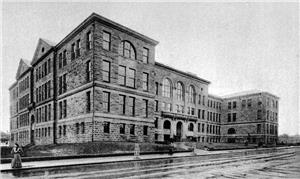In 1902, Broadway High School opens (as Seattle High School) on Capitol Hill on the corner of Broadway and E Pine Street. It is Seattle's first building specifically constructed as a high school. The architects are William E. Boone and J. M. Corner. The building is controversial for its large size and location (then remote from downtown) but within a year is filled to capacity. The 1903 class has 103 graduates, the largest graduating class in the history of Seattle. Today a remnant of the building is incorporated into Seattle Central Community College's Broadway Performance Hall.
Students from Everywhere
Seven years after it opened in 1902, Seattle High School was renamed for the avenue it faced (Broadway). At first students from everywhere from Bothell to Broadway came to the city's first dedicated high school. But with the1907 opening of a second high school, Lincoln in the Wallingford neighborhood, the name was changed. Broadway High was a remarkably busy place, and distinguished for its mix of classes and races.
The addition of night classes in 1907 swelled enrollment by nearly a thousand. Since many of these after-hours students were adults, Broadway High became a progressive complement to the entire Capitol Hill community.
Reservoir and Playing Field
With no athletic field of its own, the students at Broadway High used the playfield developed just south of what was then still called the Lincoln Park Low Reservoir (today the reservoir is lidded and remains underneath the Cal Anderson Park). Both the reservoir and park were one short block east of the school. Like the high reservoir at Volunteer Park, the low one was built in 1900 for the then new Cedar River gravity water supply. In their 1903 description of the park, the Olmsted Brothers recommended that there be "no provision for the more vigorous forms of play." Their plans for the park were "particularly designed to make baseball impractical."
Neighbors, including high school students, in need of vigorous play -- especially baseball -- overturned this prescription of the Boston-based landscapers in less than a month.
When the national playground movement swept into Seattle in 1909, Lincoln Park was assigned its first supervisor for girls. Park department statistics for the summer of 1909 lean impressively toward "girls ranging in age from 4 to 14 years." Of the average of 850 childrenwho played on the apparatuses of Seattle's four supervised playgrounds that summer, a large majority -- 550 -- were girls.
In 1980, the name of the playfield was changed again, this time to honor Robert Morris, who for 10 years supervised the play there.
Adult Learning
During the 1930s, Broadway High School also became a self-help center for learning skills to make it through the Great Depression. With Edison Technical School, its neighbor joined at the hip, the high school organizedclasses to help run the home front during World War II. After the war, a variation on this program continued with classes for returning veterans. To make room for the vets, Broadway High ceased to be a high school. In 1946, itssecondary students were redirected to Lincoln High and to other secondary schools.
However, high school education continued on the site for adults. In the Broadway-Edison Evening School anyone -- in 1945 the oldest student was 66 -- could follow a hobby, take a class in making clothes, painting, or cooking, or complete high-school credits. Adult education enrollment in 1949 was 9,645.
In 1966, Seattle Community College purchased the old stone plant for its central branch. In the summer of 1974 wreckers razed most of it. Only the school's auditorium was saved and a selection of large stones salvaged from the front entrance on Broadway. These were used in a new façade for the renamed Broadway Performance Hall, which remains an important cultural venue for Capitol Hill arts and lectures.

